I’ve always been captivated by the intricate patterns and designs that can be created with Swedish Huck Weaving.
This traditional embroidery technique, also known as “Huck Embroidery,” has roots in Sweden and is named after the huck fabric that’s typically used.
So, what exactly is Swedish Huck Weaving? Well, it’s a form of loom weaving that utilizes a specific kind of fabric – huck toweling.
This fabric has loose threads on one side that are perfect for weaving colorful yarns and threads into beautiful patterns without passing through to the other. The results can be simply stunning!
In our modern world of machine-made items, there’s something extraordinary about creating handmade pieces using traditional methods like Swedish Huck Weaving.
Whether you’re looking to try a new hobby or make unique gifts for loved ones, this age-old art form could be just what you’re searching for!
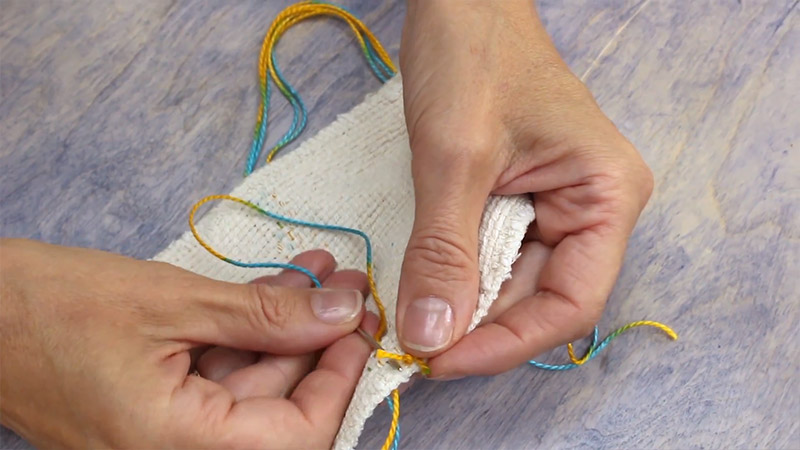
What Is Swedish Huck Weaving?
Have you ever encountered the term ‘Swedish Huck Weaving’ and wondered what it’s all about? Well, allow me to shed some light on this fascinating craft.
Originating from Sweden, as the name suggests, Swedish Huck weaving is a type of embroidery technique that’s been around for centuries.
It’s a unique form of needlework that uses a particular fabric known as huck toweling. This fabric, characterized by its distinctive loose weave and small loops, primarily makes Swedish Huck weaving possible.
The weaver takes a threaded needle under these loops without penetrating the fabric, which sets it apart from other embroidery forms.
The magic lies in its simplicity and versatility. You don’t need complicated stitches here; you work with basic ones like running stitches or darning patterns.
But despite its simplicity, Swedish Huck weaving allows for creating intricate designs ranging from geometric shapes to elaborate floral motifs.
Here are some interesting facts about Swedish Huck weaving:
- It’s also known as “Huck Embroidery” or “Huckaback darning.”
- Traditionally used for household items such as dishcloths or hand towels.
- It was enormously popular in America during the 1930s and 1940s.
While it may seem old-fashioned to some, there’s been a recent resurgence in popularity among crafting enthusiasts who appreciate traditional techniques.
So, if you’re exploring new crafts or love the charm of vintage styles, I’d suggest trying Swedish Huck Weaving!
The History of Swedish Huck Weaving: Preserving Tradition Through Threads

Swedish huck weaving, a cherished craft that intertwines artistry with practicality, traces its roots back to the early 20th century in Sweden.
Born out of necessity and cultural heritage, this weaving technique has woven its way into the fabric of Swedish history, embodying the resilience and creativity of its people.
Origins and Evolution
The story of Swedish huck weaving begins with the need for functional yet aesthetically pleasing household textiles. Artisans crafted intricate designs on towels, table runners, and curtains using a unique weave structure called huckaback.
The name “huck” is derived from this distinctive fabric, which provided an ideal canvas for elaborate embroidery.
Sustainable Traditions
At the heart of Swedish huck weaving lies a tradition of sustainability and resourcefulness. Weavers often repurposed leftover threads, ensuring that every fiber found purpose and nothing went to waste.
This mindful approach reflected the era’s pragmatism and gave each piece a sense of history and craftsmanship.
Resilience in Adversity
Swedish huck weaving took on new significance during times of hardship, such as World War II. In the face of scarcity of materials, artisans adapted their craft, ingeniously utilizing recycled threads from old garments or repurposed textiles like flour sacks.
This resilience not only preserved the tradition but also showcased the adaptability and creativity of Swedish artisans.
Challenges of Modernization
With the advent of industrialization, Swedish huckweaving encountered difficulties. Textile machinery revolutionized production methods, leading to the decline of handmade textiles.
As mass-produced alternatives flooded the market, traditional crafts faced the threat of obsolescence.
A Renaissance of Craftsmanship
Recently, there has been a resurgence of interest in handmade crafts, including Swedish huck weaving. Modern artisans are rediscovering and reinventing this timeless art form, infusing traditional patterns with contemporary flair.
This revival celebrates Sweden’s rich cultural heritage and honors the legacy of generations of skilled weavers.
Preserving Cultural Heritage
Exploring the history of Swedish huck weaving reveals a tapestry of tradition woven with threads of ingenuity, resilience, and craftsmanship.
From its humble beginnings as a practical craft to its enduring legacy as a symbol of cultural identity, huck weaving continues to captivate and inspire.
By preserving and passing down this cherished tradition, we pay homage to the artisans who came before us and ensured their legacy lives on for generations.
Characteristics of Swedish Huck Weaving: Crafting with Texture and Tradition
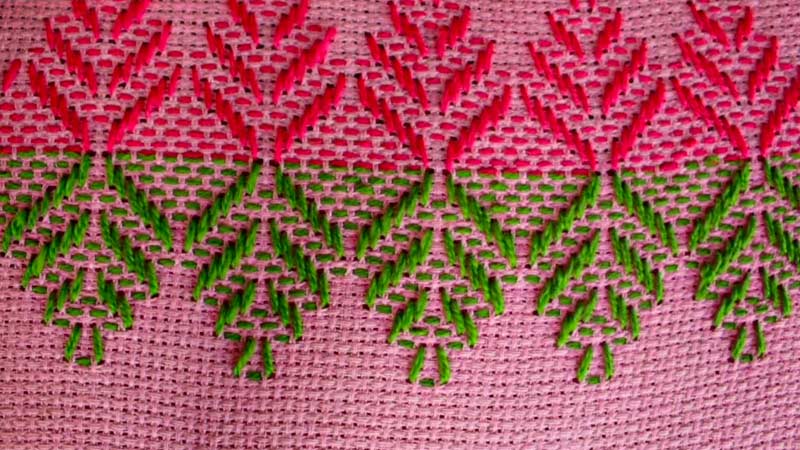
Swedish huck weaving, also known as huckaback darning or simply ‘huck,’ stands out in embroidery with unique characteristics that blend texture, tradition, and versatility.
Distinctive Texture with Huck Toweling
At the heart of Swedish huck weaving lies its distinctive texture, achieved through huck toweling. This specialized fabric boasts a loose weave with prominent ‘floats’ or threads on the surface.
These floats are the foundation for intricate designs, creating a relief effect that adds depth and dimension to the finished piece.
Rule-bound Patterns for Creative Expression
Unlike some embroidery styles, Swedish huck weaving follows specific rules regarding patterns. Designs must adhere to the floats, avoiding crossover between rows.
While this might initially seem restrictive, it opens up a world of creative possibilities within geometric shapes and patterns. The design potential is vast and captivating, from simple stripes and checks to elaborate diamonds and zigzags.
Forgiving Nature for Beginners
One of the most appealing aspects of Swedish huck weaving is its forgiving nature, particularly for beginners unlike traditional embroidery, where stitches pierce through layers of fabric, huck-weaving stitches loop around individual threads.
This means that mistakes can be easily undone without leaving noticeable marks, making it an ideal craft for those new to needlework.
Versatility Across Projects
Traditionally used for household items such as table runners and dishcloths due to their durability and absorbency, Swedish huck weaving has transcended its utilitarian roots.
Today, you’ll find it applied creatively, from intricate wall hangings to stylish clothing accessories. Its adaptability across different projects allows artisans to explore and experiment with the craft in new and exciting ways.
How to Get Started with Swedish Huck Weaving: A Beginner’s Guide to Crafting with Thread and Texture
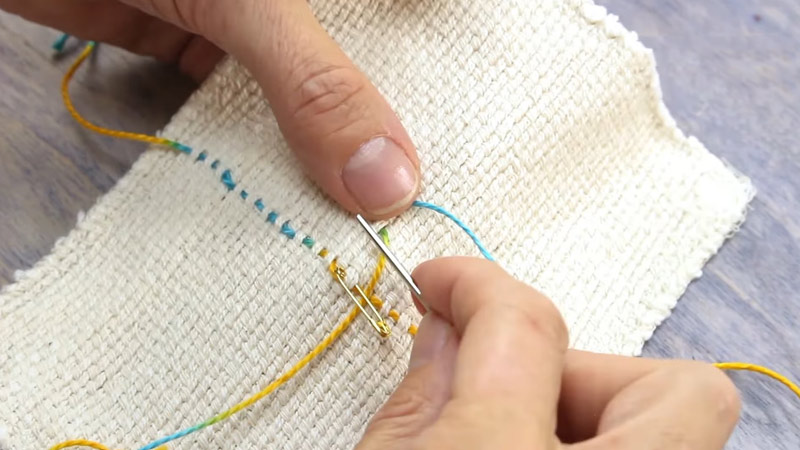
Embarking on the journey of Swedish Huck weaving is an exciting venture into the world of intricate designs and tactile surfaces.
Here’s a comprehensive guide to help you begin your huck-weaving journey with confidence and enthusiasm:
Gather Your Materials
The first step in starting Swedish Huck weaving is gathering the necessary materials:
- Huck Cloth: This specialized fabric is the foundation of huck weaving, featuring loosely woven threads. It can be found in craft stores or purchased online.
- Embroidery Floss or Yarn: Depending on your desired look, choose between embroidery floss for fine detail or yarn for a bolder, chunkier design.
- Needle: Opt for a blunt tapestry needle, which glides between the threads of the huck cloth without piercing it.
- Pattern: As a beginner, starting with a pattern can provide helpful guidance. Look for free patterns designed for beginners, available online or in crafting books.
Learn the Basic Technique
Understanding the fundamental technique of Swedish Huck weaving is essential for success. The method involves slipping the needle under groups of threads, known as ‘floats,’ on top of the cloth without penetrating the fabric.
You can create intricate designs and patterns by threading under these floats in various sequences.
Practice, Practice, Practice
Like any craft, practice is critical to mastering Swedish Huck weaving. Don’t be discouraged by initial imperfections perseverance and repetition will lead to improvement over time.
Start with simple patterns and gradually challenge yourself with more complex designs as your skills progress.
Seek Inspiration and Resources
Immerse yourself in inspiration and learning resources to enhance your huck weaving journey. Explore books dedicated to huck weaving for valuable insights and techniques.
Additionally, take advantage of written and video tutorials where experienced crafters share tips, tricks, and creative ideas.
Enjoy the Journey
Above all, remember to enjoy the process of Swedish Huck weaving. It’s a rewarding and meditative craft that allows you to express your creativity while honing your skills.
Take pride in each stitch and embrace the unique texture and dimensionality that huck weaving offers.
Exploring the Artistry: Different Techniques in Swedish Huck Weaving
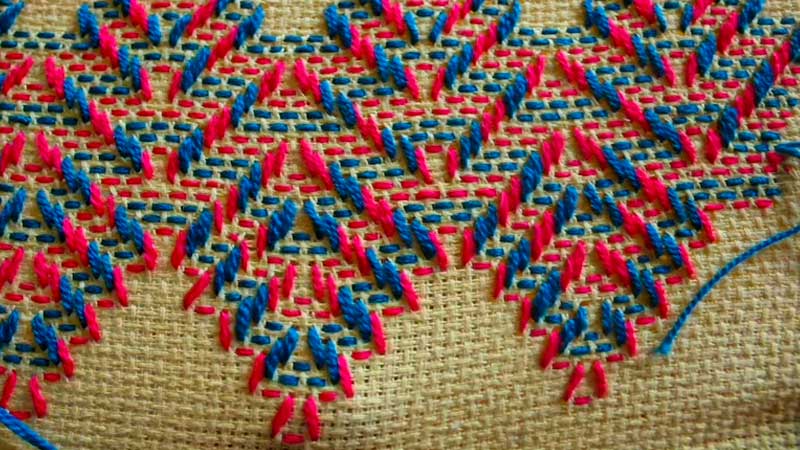
Swedish Huck weaving, celebrated for its intricate designs and tactile textures, offers a rich tapestry of techniques that elevate the craft to new heights of creativity and expression.
Let’s delve into the diverse range of techniques commonly employed in this traditional needlework:
Basic Float Stitch: Foundation of the Craft
At the heart of Swedish Huck weaving lies the basic float stitch, a fundamental technique that forms the building blocks of intricate designs.
This technique involves threading a needle under groups of threads on the fabric’s surface without penetrating to the other side.
Crafters can manipulate the floats to create patterns ranging from simple stripes to complex geometric shapes, showcasing the versatility and adaptability of the craft.
Loops or Picots: Adding Dimension and Texture
Another popular technique in Swedish Huck weaving is the incorporation of loops or picots. By leaving loose loops of thread on the surface while executing float stitches, artisans introduce dimension and texture to their designs.
These loops create visual interest and depth, allowing some aspects of the pattern to stand out and catch the eye.
Double-Sided Huck Weaving: Symmetrical Beauty
A technique that requires precision and skill, double-sided huck weaving produces designs that are mirrored identically on both sides of the fabric.
This approach offers a professional finish, particularly suited for items like table runners and placemats viewed from all angles.
Crafters adept at double-sided huck weaving can achieve stunning symmetry and balance in their projects, elevating them to works of art.
Personalization and Exploration
While these techniques represent standard practices in Swedish Huck weaving, it’s essential to recognize that there is no singular “right” way to approach the craft.
Some artisans may prefer even-numbered floats for their designs, while others may favor odd-numbered floats for added complexity.
The beauty of Swedish Huck weaving lies in its versatility and adaptability, allowing crafters to explore different approaches and techniques to suit their personal style and creative vision.
Embracing Practice and Mastery
As with any craft, mastering Swedish Huck weaving techniques requires dedication, patience, and practice. Experimentation and exploration are vital to discovering what works best for individual projects and designs.
With each stitch, artisans deepen their understanding of the craft and refine their skills, ultimately creating unique and exquisite works of art that showcase the beauty and intricacy of Swedish Huck weaving.
Tips and Tricks for Swedish Huck Weaving: Navigating the Threads with Skill and Finesse
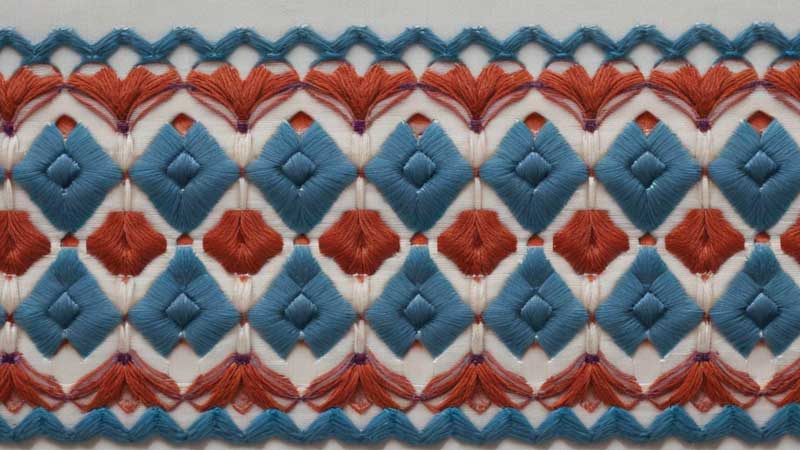
Embarking on the journey of Swedish huck weaving is an exciting adventure filled with creativity and craftsmanship.
Here are some invaluable tips and tricks to help you navigate the threads and stitches with skill and finesse:
Fabric Exploration
While traditional huck toweling is a classic choice, don’t hesitate to explore alternative fabrics such as monk cloth or Aida cloth. These fabrics can be forgiving for beginners and offer opportunities for experimentation and creativity.
Needle Selection
Opt for a blunt needle when starting your project. Sharp needles may split the threads of your fabric, leading to uneven patterns. A blunt needle glides smoothly between the threads, ensuring precise and consistent stitching.
Pattern Progression
Begin your Swedish huck-weaving journey with simple geometric shapes or straight lines before advancing to more intricate designs. Starting with manageable patterns allows you to build confidence and master the fundamental techniques gradually.
Neatness Matters
Maintain the wrong side (the back) of your work neat. This practice may seem minor, but it helps prevent thread tangling and ensures smoother weaving. A clean, wrong side contributes to your finished piece’s overall quality and professionalism.
Gentle Weaving
Avoid pulling too hard on your thread as you weave. Gentle, controlled movements help preserve the loops’ integrity and prevent fabric distortion. Aim for even tension to achieve crisp and uniform patterns.
Contrast for Impact
Experiment with contrasting colors between the embroidery floss and the base material to make your design stand out.
Bold contrasts enhance the visual impact of your work, adding depth and dimension to your creations.
Embrace Creativity
Remember, Swedish huck weaving has no strict rules—only guidelines to inspire creativity. Explore different techniques, experiment with color combinations, and allow yourself the freedom to innovate and express your unique artistic vision.
Swedish Huck Weaving Patterns and Designs: Exploring the Tapestry of Creativity
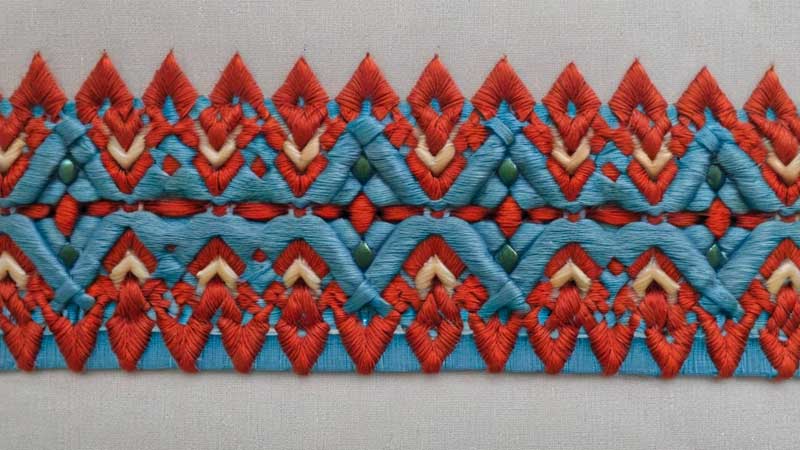
Swedish Huck weaving offers a captivating canvas for many patterns and designs, from traditional motifs to modern interpretations.
Let’s delve into the rich tapestry of creativity that defines this timeless craft:
Traditional Motifs
Rooted in Scandinavian heritage, Swedish Huck weaving traditionally features repeating patterns inspired by nature and geometric shapes.
Floral motifs, leaves, triangles, diamonds, and circles are common themes, creating visually rhythmic designs that reflect the simplicity and beauty of Nordic aesthetics.
Minimalistic Elegance
Characteristic of Nordic design, Swedish Huck weaving embraces simplicity and minimalism. Clean lines and subtle textures, combined with the softness of huck toweling, evoke a modern and understated elegance.
The beauty of minimalistic designs lies in their ability to make a statement through subtlety and refinement.
Creative Experimentation
While traditional patterns offer a starting point, don’t hesitate to unleash your creativity and experiment with your designs. Explore essential elements such as loops, floats, and bundles to create unique textures and effects on your huck cloth.
The versatility of Swedish Huck weaving allows for endless possibilities, limited only by your imagination.
Hybrid Techniques
A recent trend in Swedish Huck weaving involves blending elements from other embroidery styles, resulting in innovative and dynamic designs. For example, combining cross-stitch motifs with classic huck-weaving patterns adds depth and dimension to the fabric.
Incorporating beads within the weave or introducing color variations within a single piece adds visual interest and complexity.
Respect for Fabric Structure
While experimenting with patterns and techniques, it’s essential to respect the structure of the fabric. Avoid piercing through the threads of the huck cloth while stitching to preserve its distinctive textured surface.
Working harmoniously with the fabric can enhance its inherent beauty and create harmonious compositions.
Contemporary Applications of Swedish Huck Weaving: Weaving Tradition into Modernity
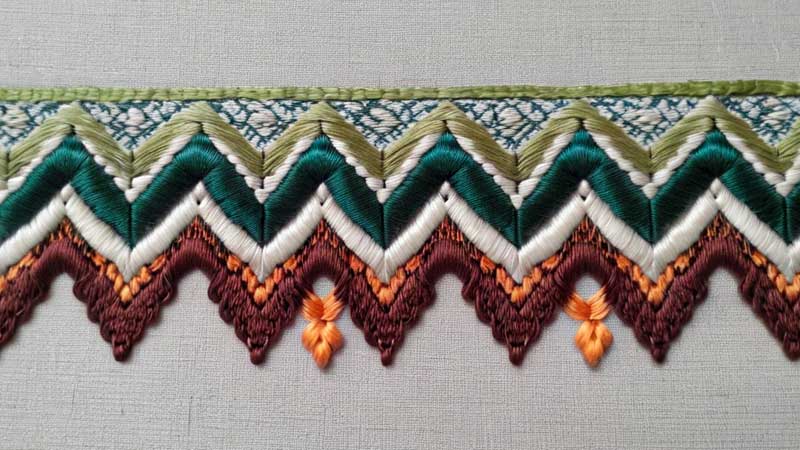
With its rich heritage and intricate techniques, Swedish Huck weaving has seamlessly transitioned into the modern world, finding new and innovative applications across various domains.
Let’s explore how this timeless craft is being revitalized and celebrated today:
Home Décor Renaissance
Reviving traditional crafts is a global trend, and Swedish Huck weaving is no exception. DIY enthusiasts and professional artisans are embracing this old-world technique to create unique home décor items such as table runners, cushion covers, and wall hangings.
These handcrafted pieces add a touch of heritage and artistry to modern living spaces, blending seamlessly with contemporary aesthetics.
Fashion Fusion
Fashion designers incorporate Swedish Huck weaving patterns into clothing designs, infusing garments with nostalgia and uniqueness.
Scarves and sweaters adorned with huck weave motifs have become popular winter accessories, offering warmth and distinctive style.
By integrating traditional weaving techniques into modern fashion, designers create fashionable pieces and carry a sense of cultural heritage.
Educational Endeavors
There has been a resurgence of interest in Swedish Huck weaving workshops and online classes, reflecting broader efforts at cultural preservation.
These educational initiatives aim to pass down traditional weaving techniques to future generations, ensuring that the artistry and craftsmanship of Swedish huck weaving are preserved and celebrated.
Participants connect with their cultural heritage while honing their creative skills by learning and practicing these age-old techniques.
Eco-Conscious Consumption
Consumers appreciate products crafted using time-honored techniques like Swedish Huck weaving in an era of heightened environmental awareness.
These items are handcrafted from natural materials and offer an eco-friendly alternative to mass-produced synthetics, aligning with sustainable lifestyle choices.
Huck woven products’ inherent durability and craftsmanship make them environmentally conscious and aesthetically appealing.
Artistic Expression
Artists increasingly utilize Swedish Huck weaving as a medium for self-expression, creating works of art that blend historical technique with contemporary creativity.
From intricate tapestries to sculptural installations, huck weaving provides a versatile canvas for artistic exploration and experimentation.
These innovative artworks showcase not only the skill and ingenuity of the artist but also the enduring relevance of Swedish huck weaving in the modern art world.
To Recap
Swedish Huck weaving is a timeless craft that blends history, creativity, and elegance. Its accessibility makes it perfect for beginners, yet its rich patterns and textures offer endless possibilities for seasoned weavers.
Through this journey, I’ve found not just a hobby but a connection to tradition and storytelling. Each stitch carries a piece of history, each pattern a tale.
Whether adorning home decor or creating fashion statements, Swedish Huck weaving is captivating with its beauty and cultural significance.
It’s more than just a craft a gateway to a world of creativity and heritage, inviting all to explore and immerse themselves in its timeless charm.
Leave a Reply